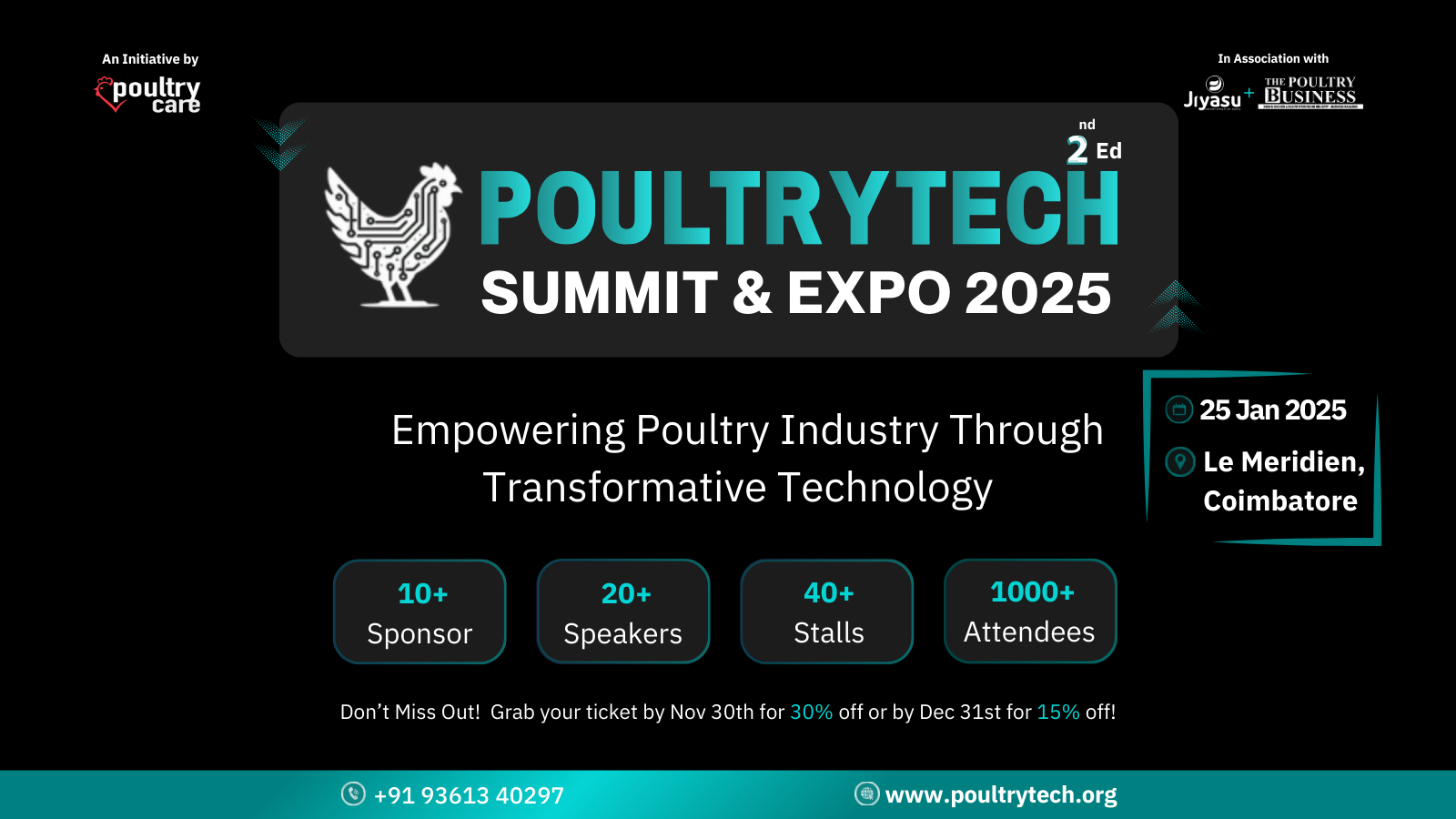In poultry farming, there's one expense that towers above all others: feed. Accounting for 70-80% of your total operational costs, feed isn't just another line item in your budget—it's the foundation of your profitability. Yet, surprisingly, most poultry businesses manage this massive expense with guesswork, rough estimates, and reactive ordering.
What if you could know exactly how much feed you need before the birds even arrive at your farm? What if you could eliminate wastage, stop unnecessary transfers, and avoid cash being locked up in excess stock?
That's exactly what Feed Projection technology makes possible. In this comprehensive guide, we'll explore how this game-changing feature is transforming poultry farm management and why it's becoming essential for modern, profitable poultry operations.
Why Feed = 70-80% of Total Poultry Cost
Let's break down a typical poultry farm's cost structure:
| Cost Component | % of Total Cost |
|---|---|
| Feed | 70-80% |
| Chicks | 8-12% |
| Medicine & Vaccines | 3-5% |
| Labor | 2-4% |
| Utilities & Others | 5-8% |
Feed is the single biggest expense. So even a 5% reduction in feed waste = massive profit improvement.
For example, if you're spending ₹50 lakhs annually on feed, reducing wastage by just 5% saves you ₹2.5 lakhs. That's pure profit added to your bottom line without selling a single extra bird.
What "Under Control" Actually Means
Before Feed Projection (Out of Control):
❌ No visibility before placement
- Company doesn't know: How much BPS, BS, BF do we need for 6,170 birds?
- Result: They order based on gut feel or past averages
❌ Over-ordering
- Let's order extra just to be safe
- Extra 500kg sitting in warehouse = ₹25,000+ blocked cash
- Risk of spoilage, especially in humid conditions
❌ Under-ordering
- Run out of feed mid-cycle
- Emergency purchases at higher prices
- Birds don't get proper nutrition → poor FCR (Feed Conversion Ratio) → lower weight → less profit
❌ Unnecessary transfers
- Farm A has excess Starter feed
- Farm B needs it urgently
- Transfer cost: ₹3-5 per kg + labor + vehicle
- For 1,000kg transfer = ₹3,000-5,000 wasted
❌ Wastage
- Feed stored badly → moisture → wastage
- Birds don't finish feed → leftover feed goes bad
- No tracking = no accountability
Net result: You're spending 70-80% of your money, but you don't know:
- How much you actually need
- How much you're wasting
- Where the leaks are
After Feed Projection (Under Control):
✅ 1. Know Exactly What You Need (Before Birds Arrive)
The system calculates:
6,170 birds × 0.4 kg BPS = 2,468 kg 6,170 birds × 1.5 kg BS = 9,255 kg 6,170 birds × 3.5 kg BF = 21,595 kg Total: 33,318 kg
Benefit: No guesswork. Order the exact amount.
✅ 2. Track Real-Time Consumption vs. Projection
| Feed Type | Estimated | Delivered | Consumed | Stock | Demand |
|---|---|---|---|---|---|
| BPS | 2,468 kg | 1,500 kg | 1,386 kg | 114 kg | 968 kg |
What this tells you:
- 1,386 kg consumed out of 1,500 delivered = 92.4% efficiency ✅
- 114 kg still in stock = proper buffer
- 968 kg still needed = plan next indent timing
Benefit: You can spot problems early:
- "Why is Farm B consuming 20% more than projection?" → Check for feed quality or spillage
- "Farm C still has 500kg stock but indent is pending" → Cancel indent, avoid overstocking
✅ 3. Prevent Overstocking & Cash Blockage
Before:
- Order 35,000 kg "just in case"
- Actual need: 33,318 kg
- Excess: 1,682 kg × ₹50/kg = ₹84,100 blocked unnecessarily
After:
- Order 33,318 kg based on projection
- Keep small buffer based on real-time stock data
- ₹84,100 stays in your pocket or can be used for other needs
Benefit: Better cash flow + no feed spoilage
✅ 4. Stop Unnecessary Transfers
Before:
- Farm A: 800kg excess BS feed
- Farm B: Shortage of BS feed
- Transfer arranged → ₹4,000 cost
After:
- Projection shows Farm B needs only 600kg more BS
- Farm A has projection showing 700kg requirement left
- No transfer needed → System suggests ordering 600kg fresh for Farm B
- Saved: ₹4,000
Benefit: Eliminate transfer logistics costs
✅ 5. Reduce Wastage with Accountability
Before:
- 5% feed wastage across farms (industry average)
- For 33,318 kg, that's 1,666 kg wasted
- Cost: 1,666 kg × ₹50 = ₹83,300 lost per batch
After:
- Real-time tracking shows: "Farm C consumed 1,800 kg but should be 1,500 kg"
- Alert triggered → Manager investigates → Finds leaking feeder
- Fix the leak → Wastage drops to 2%
- Saved: ₹50,000 per batch
Benefit: Data-driven wastage control
Real Cost Impact Example
Scenario: 10,000 bird batch
| Metric | Without Projection | With Projection | Savings |
|---|---|---|---|
| Feed ordered | 56,000 kg (buffer) | 54,000 kg (accurate) | 2,000 kg |
| Cost of excess | ₹1,00,000 | - | ₹1,00,000 |
| Transfer costs | ₹8,000 (2 transfers) | ₹0 | ₹8,000 |
| Wastage (5% vs 2%) | 2,800 kg = ₹1,40,000 | 1,080 kg = ₹54,000 | ₹86,000 |
| Total Savings | - | - | ₹1,94,000 per batch |
If you run 6 batches/year:
- Annual savings = ₹11,64,000 (₹11.6 lakhs)
- That's profit directly added without selling one extra bird!
What "Control" Really Means
✅ Visibility: You see the full picture before, during, and after
✅ Predictability: No surprises, no panic buying
✅ Accountability: Track which farm is efficient vs. wasteful
✅ Decision Power: Data-backed indent planning, not guesswork
✅ Profit Protection: 70-80% of your cost is now managed, not just spent
How Feed Projection Works in Practice
Feed Projection is a data-driven forecasting system that calculates exact feed requirements for your poultry flock before birds are even placed at the farm. Think of it as having a crystal ball that shows you precisely what you'll need across the entire growth cycle.
The Core Components
Per-Bird Consumption Standards
The system uses established feeding standards for each growth stage:
- Broiler Pre-Starter (BPS): 0.4 kg per bird
- Broiler Starter (BS): 1.5 kg per bird
- Broiler Finisher (BF): 3.5 kg per bird
- Total per bird: 5.4 kg
These standards are based on optimal nutrition requirements and typical consumption patterns for healthy growth.
Flock Size Calculation
Once you know your flock size (say, 6,170 birds), the system automatically calculates total requirements across all feed stages, giving you complete visibility before placement.
Real-Time Tracking Dashboard
The system provides a comprehensive view showing:
- Estimation: Total feed projected for the batch
- Delivered: How much has been supplied to the farm
- Consumed: Actual feed usage tracked daily
- Stock: Current inventory at the farm
- Indent: Pending feed orders
- Demand: Remaining feed needed to complete the batch
Implementation: How to Get Started
Step 1: Set Up Accurate Standards
Work with your nutritionist to establish:
- Standard feed consumption per bird for each growth stage
- Acceptable variance ranges (±2-3%)
- Adjustments for seasonal factors
Step 2: Integrate with Your Ordering Process
Before placing any bird batch:
- Enter flock size into the system
- Review complete feed projection
- Schedule feed deliveries based on growth timeline
- Set up automatic alerts for when to order next stage
Step 3: Train Your Team
Ensure farm managers understand:
- How to read projection dashboards
- When to investigate consumption variances
- How to update actual consumption data daily
Step 4: Monitor and Optimize
Weekly activities:
- Compare actual consumption vs. projection
- Investigate any variances above 5%
- Identify and fix wastage sources
- Refine projection standards based on actual performance
Step 5: Scale Across All Farms
Once optimized at one location:
- Roll out to all farm locations
- Compare performance across farms
- Share best practices from top-performing locations
- Create healthy competition for efficiency
Beyond Cost Control: Additional Benefits
While cost savings are the primary benefit, Feed Projection delivers several additional advantages:
Better Supplier Relationships
Predictable ordering patterns allow you to:
- Negotiate volume discounts
- Secure better payment terms
- Ensure consistent feed quality
- Build reliable supply partnerships
Improved Decision Making
Data-driven insights help with:
- Determining optimal flock sizes for your capacity
- Planning expansion based on feed logistics
- Evaluating farm manager performance objectively
- Making informed investments in storage and handling
Reduced Stress and Chaos
No more:
- Panic calls about running out of feed
- Last-minute emergency orders
- Finger-pointing about who ordered too much or too little
- Uncertainty about cash requirements
Environmental Benefits
Less wastage means:
- Reduced environmental impact
- Lower carbon footprint from production and transport
- More sustainable farming practices
- Better corporate responsibility profile
The Future of Feed Management
Feed Projection is just the beginning. The future of poultry feed management includes:
- AI-powered predictions that factor in weather, market conditions, and bird genetics
- Automated ordering systems that place orders without human intervention
- Blockchain integration for complete feed traceability from mill to bird
- IoT sensors that automatically track feed levels and consumption
- Predictive maintenance for feeding equipment to prevent wastage
But you don't need to wait for the future. Feed Projection technology is available and proven today.
Conclusion: Your Biggest Cost Deserves Better Control
In poultry farming, feed is your biggest expense—and your biggest opportunity. Every kilogram wasted, every rupee tied up in excess inventory, and every unnecessary transfer is profit walking out the door.
Feed Projection technology transforms this largest cost center from a source of constant stress and leakage into a controlled, optimized, predictable part of your operation. It's not about spending more or working harder—it's about working smarter with better information.
The farmers and companies already using Feed Projection are seeing:
- ₹10-15 lakhs saved annually per 10,000 birds
- 3-5% reduction in feed wastage
- Zero unnecessary transfers
- Better cash flow and reduced working capital needs
- Improved bird performance through consistent nutrition
The question isn't whether you can afford to implement Feed Projection. The question is: Can you afford not to?
Your biggest cost deserves better control. Your profit depends on it.



